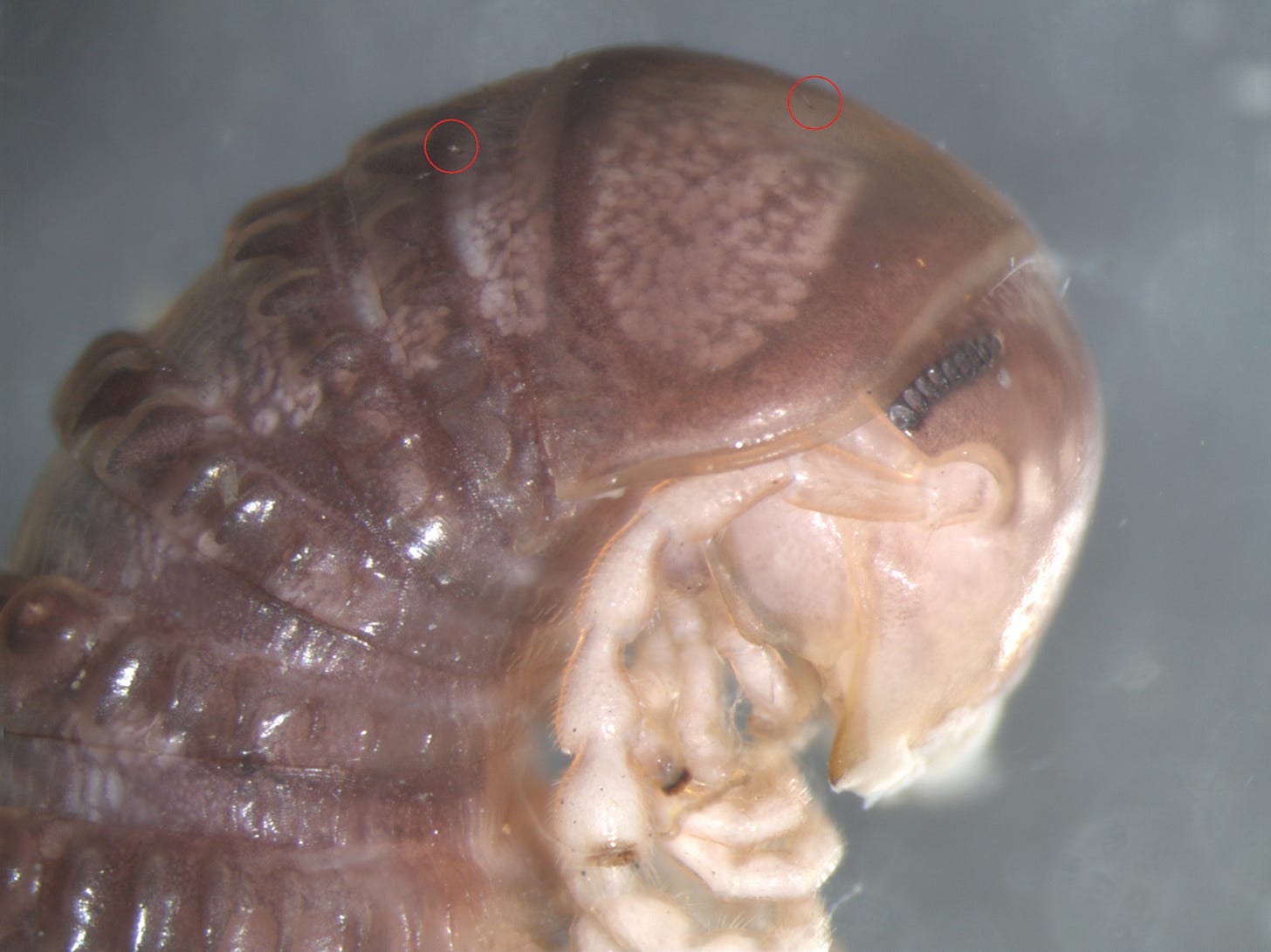In the fast-moving world of social media, I wonder how long Twitter will be around and whether, a couple generations from now, anyone will remember what Twitter was. Even if its current impacts become diminished or forgotten, its name will not. Its immortality began in a most unlikely place. A tweet posted by Derek Hennen of Virginia Tech that included a picture of a millipede, the group he studies. Thousands of miles away, a scientist in Copenhagen was suspicious about a couple of specs in the image, little more than dots. Turning to museum specimens of millipedes, it was quickly confirmed that these tiny structures were in fact a fungus in the Laboulbeniales. The result? A new species was discovered. It has been named Troglomyces twitteri, enshrining Twitter in the permanent archives of mycological nomenclature.
Cambala annulata, male. USA, Ohio, Adams County, West Union, Greene Township, Edge of Appalachia Preserve System, Abner Hollow Rd., on Bisher Dolostone Cliffs. Original image of millipede shared on Twitter on October 31, 2018, by Derek Hennen. Red circles show positions of two thalli of Laboulbeniales. From Santamaria, Enghoff & Reboleira (2020). Creative Commons license CC BY 4.0.
To the untrained eye, and insufficiently magnified, labouls look a bit like little fingers or pencils standing on end on the cuticle of an insect or related arthropod, in this case a millipede. About 80% of labouls are associated with beetles, 10% with flies, and the rest across a broad smattering of insects, mites, and other arthropods. Love is truly be in the eye of the beholder, perhaps explaining the fixation on these little fungi by Harvard professor Roland Thaxter, beginning about 1890 and persisting until the 1930s. Over four decades, Thaxter described and named 103 genera and 1,260 species of labouls. These numbers are even more impressive when we recall that when Thaxter began his studies, only 15 labouls were known. An additional 700 or so species have been named since Thaxter’s time, and it is believed that many more species await discovery, Troglomyces twitteri being among the latest examples.
A curious pattern confounded biologists for a long time. The fact that labouls may be limited to one or a few host species, or to a group of related hosts, is not at all unusual in the world of parasites. What was weird was that these fungi tended to be found not only on individuals of the same hosts, but on surprisingly specific locations of its body. One species might be found near the posterior corners of the pronotum, another on the femur of a middle leg. Confirmation of the answer to this puzzle came not all that long ago, in 2012, with work by Goldman and Weir who saw the connection between body location and host sexual behavior. Males of many arthropods grasp or otherwise contact the female in a very specific way during copulation and this, it turns out, is when the fungus is spread. This is borne out in the genus Troglomyces where labouls are associated with the third and seventh body rings, the locations of the gonopores and gonopods, respectively, that come into contact during millipede sex.
There is a great story, perhaps apocryphal, about Professor Thaxter. It is said that he gave a lecture, open to the public, about his work on labouls. Afterward, a woman in the audience said, “Professor Thaxter, all of this is fascinating, but of what use is it to mankind?” Thaxter stood back, thought for a moment, then replied “None, thank God!” I have always loved pure science, exploration and research driven by raw curiosity and nothing more. No expectation of riches, or curing a disease, simply the intellectual pleasure of learning things new. This quote, accurate or not, is a wonderful encapsulation of that romantic vision of basic science.
There is so much yet to be learned about labouls. A paper, just last year, by Reboleira and colleagues described how some labouls have a structure that penetrates the cuticle of the host, while others are simply attached to the surface. This reveals yet another unexpected pattern regarding where, on the host body, these fungi are found. Those that penetrate the cuticle seem especially common on the abdomen where intersegmental membranes may make penetration easier, and inside of which are found the greatest stores of fatty tissues and nutrients. From species diversity to host preferences, location on host, development, physiology, and transmission, science has only begun to unravel the fascinating story of the lives and evolution of these most unusual fungi.
Further Reading
Blackwell, M. Haelewaters, D., and D.H. Pfister (2020) Laboulbeniomycetes: Evolution, natural history, and Thaxter’s final word. Mycologia 112: 1048-1059.
Goldman, L. and A. Weir (2012) Position specificity in Chitonomyces (Ascomycota, Laboulbeniomycetes) on Laccophilus (Coleoptera, Dytiscidae): a molecular approach resolves a century-old debate. Mycologia 104: 1143-1158.
Reboleira, A. S. P. S., Moritz, L., Santamaria, S., and H. Enghoff (2021) Penetrative and non-penetrative interaction between Laboulbeniales fungi and their arthropod hosts. Nature Scientific Reports 11 (22170).
Santamaria, S., Enghoff, H., and A. S. Reboleira (2020) The first Laboulbeniales (Ascomycota, Laboulbeniomycetes) from an American millipede, discovered through social media. MycoKeys 67: 45-53.
Weir, Alex (September 9, 2022) Website: Biology of Laboulbeniales.




